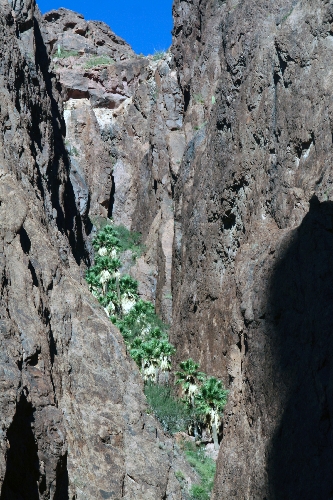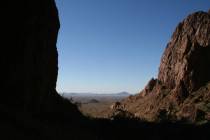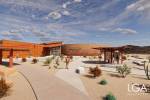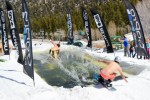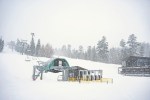Exotic palms adorn wildlife refuge
While the native California fan palm (Washingtonia filifera) can be found in several areas in California, including Joshua Tree National Park and near Palm Springs, there is one hidden spot in Arizona where it also can be found.
Dozens of these impressive palms thrive in a microclimate within a narrow and steep canyon in the Kofa National Wildlife Refuge in the Sonoran Desert just south of Quartszite. The refuge encompasses about 665,000 acres and was established in 1939, primarily to protect the desert bighorn sheep. There are about 400 to 800 sheep in the refuge nowadays.
Palm Canyon is on the northwest area of the refuge and was eroded out of a wall of rhyolite, a volcanic rock. From the large parking area, pick up the well-signed trail and head toward the canyon. You will find an interesting mix of plants along the way, including cholla, saguaro, ocotillo, palo verde and ironwood. As you near the trail's end, look for a few small bushes that have leaves resembling holly. This is Kofa Mountain barberry, an uncommon plant.
A variety of birds enjoy the canyon's environment as much as the plants do. Look for gnatcatchers, canyon towhees, thrashers, white-throated swifts and canyon wrens.
After about one-half mile of hiking from the trailhead, you will see a basic wood sign that says, "Palms," with an arrow.
Believe it or not, many people would miss the palms without this sign as they are up a narrow side canyon, on the north side of the main canyon. They're in the shade most of the day, so try to plan your visit at midday, when the sun lights them up.
The palms appear strong and healthy, apparently thriving in this microclimate of the canyon. As the older and lower palm fronds die, they fold downward and form a thick petticoat around the trunk, for a few feet beneath the crown. When these dead fronds eventually fall to the ground, they decompose, forming perfect conditions for the growth of new trees.
You can travel up to the palms, but although it takes only about a half-hour round-trip, it is a steep and strenuous hike.
If you're not up for that much exertion, you can see a few palms growing, though not so impressively, farther up the main canyon. There are also a few palms in nearby Fishtail Canyon, southeast of Palm Canyon.
Dispersed camping - what some of us call real camping - is allowed in this refuge. Officials ask that you not camp within a quarter-mile of any water source and be within 100 feet of a designated road. Campfires are permitted, but you will need to bring your own firewood. The average high daily temperature in January is 65 degrees.
Deborah Wall is the author of "Great Hikes, A Cerca Country Guide" and "Base Camp Las Vegas: Hiking the Southwestern States," published by Stephens Press. She can be reached at deborabus@aol.com.
DIRECTIONS From Las Vegas, take U.S Highway 95 south about 100 miles toward Searchlight/Needles. Go left onto U.S. Interstate 40 east/ U.S. 95 south for about 10.7 miles. Take exit 144, U.S. 95 south, toward Blythe. Drive for about 93 miles and merge onto I-10 west. Drive about 21 miles to Quartzsite. From Quartzsite, take U.S. 95 south for about 18 miles and go left into the Kofa National Wildlife Refuge. Drive about seven miles on the well-maintained gravel road toward the large black mountain and parking area for Palm Canyon.



